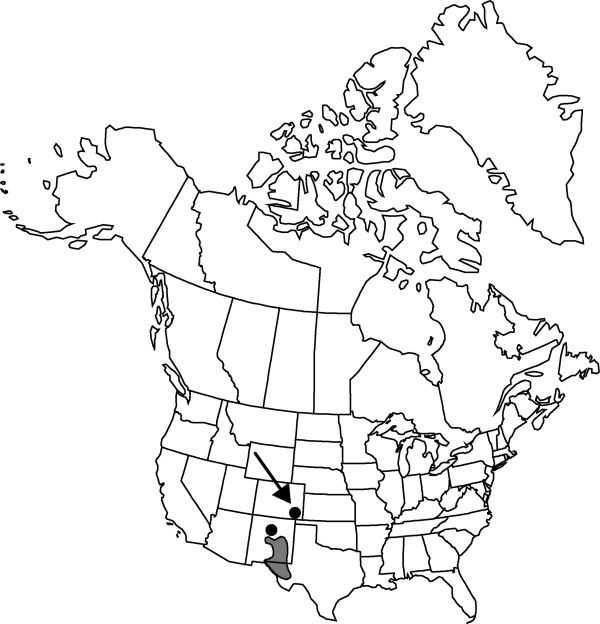Difference between revisions of "Abronia carletonii"
Bot. Gaz. 17: 349. 1892.
FNA>Volume Importer |
imported>Volume Importer |
||
| (7 intermediate revisions by 2 users not shown) | |||
| Line 6: | Line 6: | ||
|place=17: 349. 1892 | |place=17: 349. 1892 | ||
|year=1892 | |year=1892 | ||
| + | }} | ||
| + | |special_status={{Treatment/ID/Special_status | ||
| + | |code=E | ||
| + | |label=Endemic | ||
}} | }} | ||
|basionyms= | |basionyms= | ||
| Line 11: | Line 15: | ||
|name=Abronia nealleyi | |name=Abronia nealleyi | ||
|authority=Standley | |authority=Standley | ||
| + | |rank=species | ||
}} | }} | ||
|hierarchy=Nyctaginaceae;Abronia;Abronia carletonii | |hierarchy=Nyctaginaceae;Abronia;Abronia carletonii | ||
| Line 19: | Line 24: | ||
}}<!-- | }}<!-- | ||
| − | --><span class="statement" id="st- | + | --><span class="statement" id="st-undefined" data-properties=""><b>Plants </b>perennial. <b>Stems</b> ascending, infrequently procumbent, unbranched to few branched, elongate, often whitish, viscid-puberulent to glandular-pubescent. <b>Leaves</b>: petiole 1–4.5 cm; blade lanceolate to elliptic-oblong, 2.5–5 × 0.5–3 cm, margins entire to ± repand and undulate, adaxial surface glabrous, abaxial surface glabrous or puberulent. <b>Inflorescences</b>: peduncle longer than subtending petiole; bracts ovate, 4–8 × 2–5 mm, papery, apex acute to acuminate, glandular-pubescent, sometimes villous basally; flowers 15–30. <b>Perianth</b>: tube greenish, 8–16 mm, limb pale pink to light magenta, 5–7 mm diam. <b>Fruits</b> turbinate, 4–17 × 3–5 mm, scarious, apex broadly obtuse and beaked; wings 5, thin walled, truncate and conspicuously dilated distally, dilations as wide as long and flattened perpendicular to plane of lamina, cavities extending throughout.</span><!-- |
-->{{Treatment/Body | -->{{Treatment/Body | ||
| + | |phenology=Flowering spring–fall. | ||
|habitat=Calcareous or gypseous, clay or silty soils, shrublands | |habitat=Calcareous or gypseous, clay or silty soils, shrublands | ||
|elevation=1000-1600 m | |elevation=1000-1600 m | ||
| Line 33: | Line 39: | ||
-->{{#Taxon: | -->{{#Taxon: | ||
name=Abronia carletonii | name=Abronia carletonii | ||
| − | |||
|authority=J. M. Coulter & Fisher | |authority=J. M. Coulter & Fisher | ||
|rank=species | |rank=species | ||
| Line 40: | Line 45: | ||
|basionyms= | |basionyms= | ||
|family=Nyctaginaceae | |family=Nyctaginaceae | ||
| + | |phenology=Flowering spring–fall. | ||
|habitat=Calcareous or gypseous, clay or silty soils, shrublands | |habitat=Calcareous or gypseous, clay or silty soils, shrublands | ||
|elevation=1000-1600 m | |elevation=1000-1600 m | ||
| Line 46: | Line 52: | ||
|publication title=Bot. Gaz. | |publication title=Bot. Gaz. | ||
|publication year=1892 | |publication year=1892 | ||
| − | |special status= | + | |special status=Endemic |
| − | |source xml=https:// | + | |source xml=https://bitbucket.org/aafc-mbb/fna-data-curation/src/2e0870ddd59836b60bcf96646a41e87ea5a5943a/coarse_grained_fna_xml/V4/V4_125.xml |
|genus=Abronia | |genus=Abronia | ||
|species=Abronia carletonii | |species=Abronia carletonii | ||
| − | |||
| − | |||
| − | |||
| − | |||
| − | |||
| − | |||
| − | |||
| − | |||
| − | |||
| − | |||
| − | |||
| − | |||
| − | |||
| − | |||
| − | |||
| − | |||
| − | |||
| − | |||
| − | |||
| − | |||
| − | |||
| − | |||
| − | |||
| − | |||
| − | |||
| − | |||
| − | |||
| − | |||
| − | |||
| − | |||
| − | |||
| − | |||
| − | |||
| − | |||
| − | |||
| − | |||
| − | |||
}}<!-- | }}<!-- | ||
-->[[Category:Treatment]][[Category:Abronia]] | -->[[Category:Treatment]][[Category:Abronia]] | ||
Latest revision as of 21:56, 5 November 2020
Plants perennial. Stems ascending, infrequently procumbent, unbranched to few branched, elongate, often whitish, viscid-puberulent to glandular-pubescent. Leaves: petiole 1–4.5 cm; blade lanceolate to elliptic-oblong, 2.5–5 × 0.5–3 cm, margins entire to ± repand and undulate, adaxial surface glabrous, abaxial surface glabrous or puberulent. Inflorescences: peduncle longer than subtending petiole; bracts ovate, 4–8 × 2–5 mm, papery, apex acute to acuminate, glandular-pubescent, sometimes villous basally; flowers 15–30. Perianth: tube greenish, 8–16 mm, limb pale pink to light magenta, 5–7 mm diam. Fruits turbinate, 4–17 × 3–5 mm, scarious, apex broadly obtuse and beaked; wings 5, thin walled, truncate and conspicuously dilated distally, dilations as wide as long and flattened perpendicular to plane of lamina, cavities extending throughout.
Phenology: Flowering spring–fall.
Habitat: Calcareous or gypseous, clay or silty soils, shrublands
Elevation: 1000-1600 m
Distribution

Colo., N.Mex., Tex.
Discussion
Selected References
None.